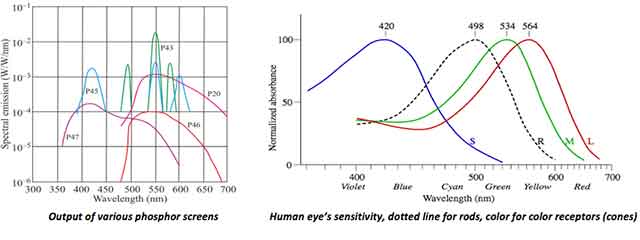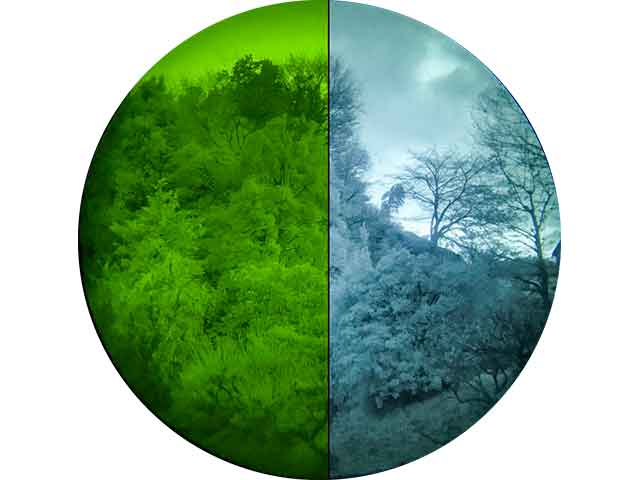Differences Between Night Vision White & Green Image
2022-08-05
Contact Engineer manager
Engineer Manager Name: Jacky
WhatsApp/ Wechat: 0086-18792456795
One of the most important parts of the IIT is its screen. It's what you see, and what converts electrons back into photons. Typically, the phosphor is deposited on the back of the fiber and then covered with a layer of aluminum. The aluminum layer increases light efficiency to almost 100% by reflecting light and reducing retained charge.
There are a number of phosphor types commonly referred to as P-numbers, namely P-22. Four parameters are the most critical for evaluating screen performance and suitability: conversion factor, spectrum, decay time, and resolution.
A. Conversion Factor
The conversion factor refers to the conversion rate of electrons to photons, so how many photons will be emitted by an electron hitting the screen?
A high conversion rate does not necessarily mean that the eye will perceive a bright image, as it all depends on the wavelength of the emitted light.
B.Spectrum
The emission spectrum of the screen i.s. P43 is 475 nm-600 nm.
C. Decay Time
The time it takes for an activated screen to return to low brightness, then it must be several times shorter than the eye's time inertia, and it is comparable to the refresh rate of a TV screen or light bulb.
D. Line Pairs
The number of line pairs (aka resolution) depends on the size of the average size of the screen particles, the larger the particles the sharper the image will be, but you will end up creating a literally grainy image, this usually stays at the final system resolution about twice.
As a fifth metric serves luminous efficiency, which is not a fixed number but describes how well a phosphor screen produces light in the visible spectrum, or in other words, how well the screen's light output matches the human eye.

E. Character of Whit and Green Phosphor

a. Green Phosphor
Advantages:
◆ The luminous efficiency is high, almost the same color as the human eye perceives green.
◆ There is unnoticeable noise.
◆ The human eye is most sensitive to the contrast with green, which is more in line with human observation.
◆ Great for static viewing.
Disadvantages:
◆ Long decay time from 60ms to 10%.
◆ Since the green image is brighter, the feeling of eye fatigue is accelerated.
b. White Phosphor
Advantages:
◆ White light feels more natural in low-light environments, which reduces eye strain and makes it easier for users to see brighter images.
◆ Most of the tubes used for white phosphorus imaging use state-of-the-art technology.
◆ Low decay time from 1.5ms to 10%.
◆ White light allows the use of rod cells in the eye, which are most sensitive in low light, to produce brighter perceived images.
Disadvantages:
◆ Lower luminous efficiency than green phosphors, resulting in darker perceived images.
◆ Few eyepieces can match the bandwidth of white phosphors, which causes chromatic aberration in the image and is difficult to design for wide bandwidths.
F. Difference Between White and Green Phosphor
1. Compared with white phosphors, green phosphors emit light more efficiently. However, in a low-light environment, white phosphors looks more natural and the image is clearer.
2. White phosphors use more advanced tubes.
3. White phosphors are less harmful to the eyes.
4. The decay time of white phosphor is less than that of green phosphor.
Summary
There is a heated debate between green and white phosphors, and both have their pros and cons. Currently, there is a clear trend from green to white in the market (especially in the US market) and this trend will continue to increase as white phosphorous pipes are now aviation certified.
But since the widespread introduction of white phosphorus tubes has only appeared in recent years, its performance and technology are definitely the most advanced, such as filmless or 4G IIT, the performance of white phosphorus tubes has improved compared to the old green phosphorus tubes.
Contact Engineer manager
Engineer Manager Name: Jacky
WhatsApp/ Wechat: 0086-18792456795
 tel
tel

